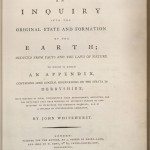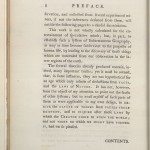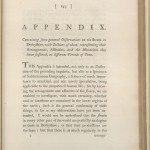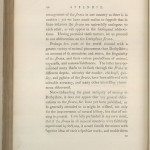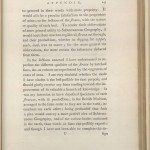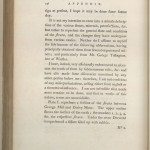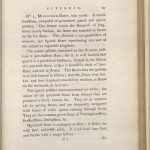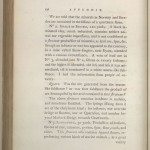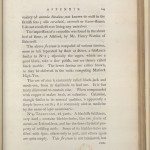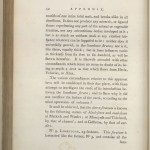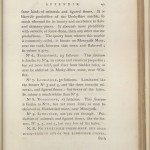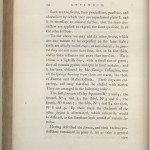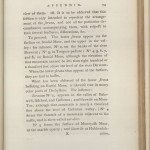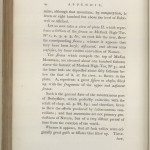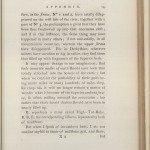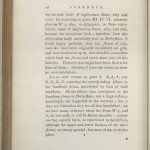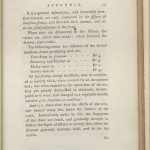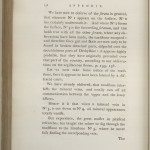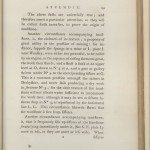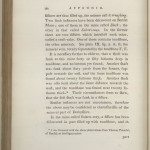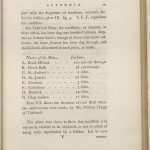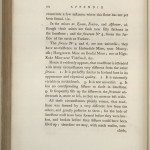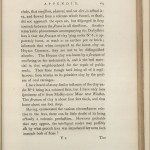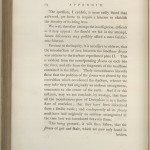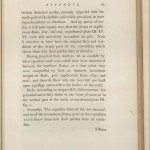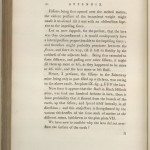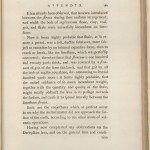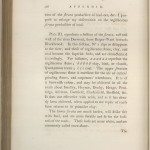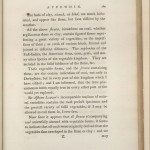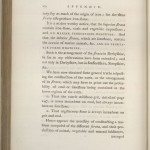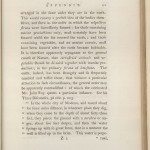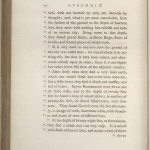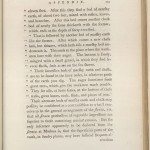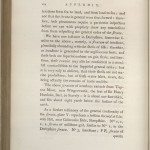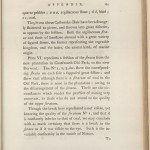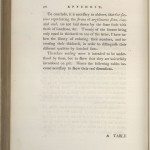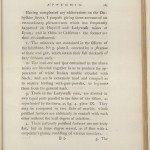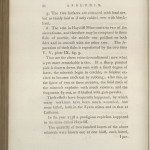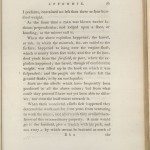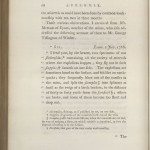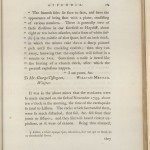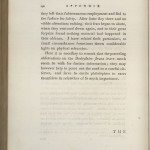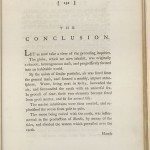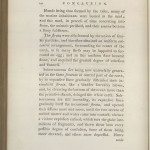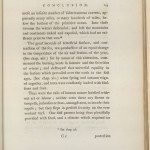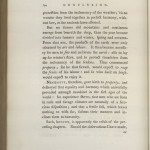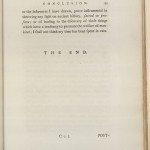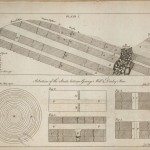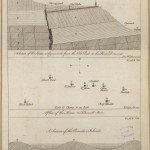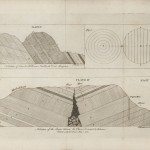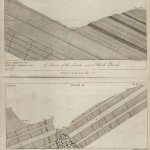John Whitehurst and 18th Century Geology
John Whitehurst (1713-1788) was the oldest member of the Lunar Society. Born in Congleton in Cheshire he moved to Derby and made a name for himself as a clockmaker and engineer in the Midlands and London and shared an interest in geology with other Lunar Society figures such as Matthew Boulton, Erasmus Darwin, Josiah Wedgwood and William Withering. In the mid-18th century the excavation of mines, canal building and the exploration of caves were providing evidence of rock formation and fossils which encouraged investigation into the origins of the earth. Derbyshire was mineralogically rich and provided fertile ground for observation and speculation. Whitehurst’s most important work, An Inquiry into the Original State and Formation of the Earth (1778), is a contribution to the evolution of geology as a major science.
The book is in two parts. The first section, An Inquiry.., takes up most of the publication. Whitehurst tried to connect his Christian beliefs in divine creation and the Flood with geological evidence for the formation of the earth. He also explored how volcanic action and subterranean fire had shaped the earth’s features, an interest he shared with his friend, the painter Joseph Wright of Derby.
The second part, the Appendix, General Observations on the Strata in Derbyshire, is a much more important section. Whitehurst provides an insight into stratigraphy, the branch of geology which deals with the nature and order in which rocks are laid down. His writing is accompanied by beautifully engraved sectional diagrams to illustrate his theories. He also established a succession for carboniferous rocks in Derbyshire from the youngest: stone, clay and coal, down to other layers such as millstone grit and shale to the oldest: limestone and toadstones. The latter he saw as creation of volcanic action. Whitehurst also explained that coal was originally derived from vegetable matter.
His work influenced other geologists.
• White Watson (1760-1836), a local millstone manufacturer, who created exquisite mineral tablets representing the strata that Whitehurst described. A selection of these is in Derby Museum.
• William Martin (1767-1810), a Derbyshire drawing master and palaeontologist, who published the first scientific accounts of fossils.
• John Farey (1766-1826), a surveyor who provided an extraordinarily detailed and accurate coloured version of the stratigraphy of Derbyshire, including its mines and collieries.
In the history of geology, Whitehurst was important. Theoretically, the subject was controversial as it progressively undermined the biblical accounts of the origins of the earth. Whitehurst was not prepared to follow this route, but the quality and depth of his work ensure that his recorded observations were major contributions to scientific understanding in the 18th century.
———————————–
AN INQUIRY INTO THE ORIGINAL STATE AND FORMATION OF THE EARTH DEDUCED FROM FACTS AND THE LAWS OF NATURE TO WHICH IS ADDED AN APPENDIX CONTAINING SOME GENERAL OBSERVATIONS ON THE STRATA IN DERBYSHIRE
WITH SECTIONS OF THEM, REPRESENTING THEIR ARRANGEMENT, AFFINITIES, AND THE MUTATIONS THEY HAVE SUFFERED AT DIFFERENT PERIODS OF TIME. INTENDED TO ILLUSTRATE THE PRECEDING INQUIRIES, AND AS A SPECIMEN OF SUBTERRANEAN GEOGRAPHY.
BY JOHN WHITEHURST
LONDON:
PRINTED FOR THE AUTHOR, BY J. COOPER IN DRURY-LANE. AND SOLD BY W. BENT, No 67, PATER-NOSTER-ROW. MDCCLXXVIII.
PREFACE
AFTER so many volumes have been written to investigate the original state and formation of the earth, and the changes it has undergone, it may appear presumptuous to offer my sentiments to the public on so extensive a subject.
But when it is considered, that the book of Nature is open to all men, and perhaps in no part of the world more so than in Derbyshire, the wonder will cease; for natural phenomena so plentifully abound, that patience and assiduity are only needful to examine those things which have a tendency to unfold the original state and formation of the earth, and the changes it has undergone. It may appear wonderful, that amidst all the confusion of the strata, there is nevertheless one constant invariable order in the arrangement of them, and their various productions of animal, vegetable, and mineral influences, or rather the figures or impressions of the two former. These appearances engaged my attention very early in life, to search and inquire into the various causes of them, and I hope that the facts which I have ascertained from my own observation, and collected from several experienced miners, if not the inferences deduced from them, will entitle the following pages to a candid examination.
This work is not wholly calculated for the entertainment of speculative minds; but, in part, to establish such a system of Subterraneous Geography, as may in time become subservient to the purposes of human life, by leading to the discovery of those things which are concealed from our observation in the lower regions of the earth.
The several theories already produced contain, indeed, many important truths; yet it must be owned, that, in some instances, they are too hypothetical for an age which only admits deductions from FACTS, and the LAWS of NATURE. It has not, however, been the object of my attention to point out the faults of other systems; but to avail myself of such parts of them as were applicable to my own design, to DERIVE the NATURE OF THINGS from CAUSES TRULY EXISTENT, and to INQUIRE after those LAWS by which the CREATOR CHOSE TO FORM THE WORLD; and not THOSE on which HE MIGHT HAVE FORMED IT, had HE so pleased.
APPENDIX
Containing some general observations on the Strata in Derbyshire, with Sections of them, representing their Arrangement, Affinities, and the Mutations they have suffered, at different Periods of Time.
This Appendix is intended, not only as an illustration of the preceding inquiries, but also as a specimen of Subterraneous Geography, a science of much importance to mankind, and not merely speculative, being applicable to the purposes of human life; for by knowing the arrangement and affinities of the strata, we are enabled to investigate, with much certainty, whether coal or limestone are contained in the lower regions of the earth; such is the general conformity of these things, so far as my observations have yet been extended. I would not be understood that the strata in every other part of the world are perfectly analogous to those in Derbyshire; or that their productions are the same: but that there is as much regularity in the arrangement of the strata in one country as there is in another: yet we have as much reason to suppose that in some instances the strata are universally analogous to each other, as will appear in the subsequent observations. Having premised these matters, let us proceed to our observations on the Derbyshire strata.
Perhaps few parts of the world abound with a greater variety of natural phenomena than Derbyshire; on account of its mountains and mines, the singularity of its strata, and their various productions of animal, vegetable, and mineral substances. The latter have occasioned many shafts to be sunk through the strata at different depths, whereby the number, thickness, quality, and position of the strata, have been observed with tolerable accuracy, and many other interesting phenomena discovered.
Notwithstanding the great antiquity of mining in Derbyshire, it does not appear that any general observations on the strata, &c. have yet been published, or so generally attended to as might be wished, not only for the improvement of natural history, but that of mining in general. I am fully persuaded in my own mind, that if the strata in all mineral countries were faithfully represented by sections, it would furnish the miners with superior ideas of their representative works, and enable them to proceed in their works with more propriety. It would also be a peculiar satisfaction to the proprietors of mines, to see sections of the strata, with the nature or quality of each bed. To render these observations of more general utility to Subterraneous Geography, it would contribute much to register all strata cut through, and their productions, whether in digging for copper, coals, lead, iron or water; for the more general the observations, the more certain the inferences deduced from them.
In the sections annexed I have endeavoured to represent the different qualities of the strata by hatched lines, &c. as colours are represented by the engravers of coats of arms. I am very doubtful whether the mode I have chosen is the best possible for that purpose, and should gladly receive any hints tending towards the improvement of so valuable a branch of knowledge. It was my intention to have deposited specimens of each stratum, with its productions, in the British Museum, arranged in the same order as they are in the earth, incumbent on each other; being persuaded that such a plan would convey a more perfect idea of Subterranean Geography, and of the various bodies contained in the earth, than words or lines can possibly express: and though I have not been able to complete this design at present, I hope it may be done for some future day.
It is not my intention to enter into a minute description of the various stones, minerals, petrefactions, &c. but rather to represent the general state and condition of the strata, and the changes they have undergone from various causes. Neither do I assume to myself the sole honour of the following observations, having principally obtained them from several experienced miners; and particularly from Mr. George Tissington, late of Winster.
I have, indeed, very assiduously endeavoured to ascertain the truth of them by subterraneous visits. &c. and have also made some discoveries unnoticed by any other person before me: therefore, I am not conscious of any misrepresentations, arising either from neglect or a theoretical influence. I am not insensible that much more remains to be done, and in works of this nature, errors are unavoidable.
Plate I. represents a section of the strata between Grange Mill and Darley Moor. The upper outline shews the surface of the earth; the numbers 1,2,3,4, &c. the respective strata. Under the river Derwent is represented a fissure filled up with rubble.
No 1. MILLSTONE-GRET, 120 yards. A coarse sandstone, composed of granulated quartz and quartz pebbles. The former retain the sharpness of fragments newly broken, the latter are rounded as stones on the sea shore. This stratum is not productive of minerals, nor figured stones representing any part of the animal or vegetable kingdoms.
The quartz pebbles contained in this stratum, indicate a pre-existent state; for it is well-known that quartz is a parasitical substance, formed in the fissures of a quartzose stone, as spar is formed in those of limestone, and not in strata. This shews that the pebbles were first formed in fissures; that the strata were broken, and their fragments rounded by attrition, as stones on the sea beach, or in rivers.
The quartz pebbles abovementioned are white; the colour of the quartzose stones from whence they are produced is black, brown, &c. They are in common use for paving streets, and are frequently variegated with seams of white quartz running through them. They are the common gravel stone of Nottinghamshire, Staffordshire, Derbyshire, &c.
Quartzose stone is analogous to flint; it strikes fire with steel, and resists acids. It is less hard than flint, and breaks with a rough surface.
We are told that the minerals in Norway and Sweden are contained in the fissures of a quartzose stone.
No2. SHALE OR SHIVER, 120 yards. A black laminated clay, much indurated, contains neither animal or vegetable impressions, and is not considered as a stratum productive of minerals, as lead ore, spar, &c. though an instance or two has appeared to the contrary, in a mine called Shaw-Engine, near Eyam, attended with a curious circumstance. A vein of lead ore in No3, ascended into No2, fifteen or twenty fathoms; and the higher it ascended, the less and less it was mineralised, till it terminated in a white mucus-like substance. I had this information from people of veracity.
Quaere. Was the ore generated from the mucus-like substance? or was that substance the product of ore decomposed by the acid contained in that stratum?
The above stratum contains ironstone in nodules, and sometimes stratified. The springs issuing from it are of the chalybeate kind: for instance, one near the bridge at Buxton, one at Quarndon, and another beyond Matlock Bridge, towards Chatsworth.
No3. LIMESTONE, 50 yards. Productive of lead ore, the ore of zinc, calamine, pyrites, spar, fluor, cauk and chert. This stratum also contains figured stones, representing various kinds of marine animals; as a great variety of anomiæ bivalves, not known to exist in the British seas; also coralloids, entrochi or screw-stones. I do not recollect ever seeing any univalves.
The impression of a crocodile was found in the above bed of stone, at Ashford, by Mr. Henry Watson of Bakewell.
The above stratum is composed of various laminæ, more or less separated by shale or shiver, a substance familiar to No2; especially the upper, which are a good black, take a fine polish, and are thence called black marble. The lower laminæ are rather brown, as may be observed in the rocks composing Matlock High-Tor.
The ore of zinc is commonly called black-jack and mock-ore, from its similitude to lead-ore. It is but lately discovered to contain zinc. When compounded with copper it makes brass, as calamine. Calamine, though similar in its mineral qualities, is apparently a simple brown earth; it is commonly used in medicine by the name of lapis calaminaris.
No4. TOADSTONE, 16 yards. A blackish substance, very hard; contains bladder-holes, like the scoria of metals, or Iceland lava, and has the same chymical property of resisting acids. Some of its bladder-holes are filled with spar, others only in part, and others again are quite empty. This stratum is not laminated, but consists of one intire solid mass, and breaks alike in all directions. It does not produce any minerals, or figured stones representing any part of the animal or vegetable creation, nor any adventitious bodies inveloped in it; but is as much a uniform mass as any vitrified substance whatever can be supposed to be: neither does it universally prevail, as the limestone strata; nor is it, like them, equally thick; but in some instances varies in thickness from six feet to six hundred, as will be shewn hereafter. It is likewise attended with other circumstances which leave no room for doubt of its being as much a lava as that which flows from Hecla, Vesuvius or Ætna.
The various circumstances relative to this apparent lava will be considered in their due place, with some attempt to investigate the cause of its introduction between the limestone strata; and to shew why it did not overflow the surface of the earth, according to the usual operations of volcanos?
It must be observed, that the above stratum is known by the following names of black-stone and toad-stone at Matlock and Winster; at Monyash and Tideswell, by that of channel; and at Castleton, by that of cat-dirt.
No 5. LIMESTONE, 25 fathoms. This stratum is laminated like the former, No3, and contains all the same kinds of minerals and figured stones. It is likewise productive of the Derbyshire marble, so much esteemed for its beauty and excellence in slabs and chimney-pieces. It abounds more plentifully with entrochi, or screw-stone, than any other marine productions. The quarry from whence this marble is commonly raised, is situate on Moneyash Moor, near the road, between that town and Bakewell; its colour is grey.
No6. TOADSTONE, 23 fathoms. This stratum is similar to No 4 in colour and chemical properties; but yet more solid, and freer from bladder-holes, as may be observed in Mosey-Meer mine, near Winster.
No 7. LIMESTONE, 30 fathoms. Laminated like the former No 3 and 5, and like them contains minerals, and figured stones; but fewer of the latter. Its colour is much whiter than No 5.
No 8. TOADSTONE, 11 fathoms. This stratum is similar to No 6, but yet more solid, as may be observed in Hubberdale mine, near Moneyash.
No9. LIMESTONE, not yet cut through. Productive of minerals and figured stones, like the former, No 3, 5, and 7, but very few of the latter.
N.B. NO VEGETABLE FORMS HAVE YET BEEN DISCOVERED IN ANY OF THE LIMESTONE STRATA.
Such are the strata, their productions, qualities, and characters by which they are represented plate I and it is necessary to observe further, that the same characters are applied to express the same qualities, in all the other sections.
To the above we may add six other strata, which are too minute to be expressed on the same scale: these are usually called clays, or way-boards; in general they are not more than four, five or six feet thick, and in some instances not more than one foot. Their colour is a lightish blue, with a small tint of green; they all contain pyrites and spar in small nodules; and is has been observed by Mr. George Tissington, that all the springs flowing from them are warm, like those of Buxton and Matlock-Bath. These clays are calcarious, and may therefore be classed with marles. They are arranged in the following order:
The first stratum of clay separates No 3 and 4; the second, No 6 and 7; the third, No 5 and 6; the fourth, No 7 and 8; the fifth, No 8 and 9, By these clays the thickness of the other strata is ascertained, which otherwise would be difficult, as the limestone beds consist of various laminæ.
Having described the strata, and their various productions in plate I, let us take a general “view of them. 1st. It is to be observed that this section is only intended to represent the arrangement of the strata, and not all the particular circumstances accompanying them, with respect to their several fractures, dislocations, &c.
To proceed. The lower strata appear on the surface at Bonsall Moor, and the upper in the valley: for instance No 2, on the banks of the river Derwent; No 3, in Trogues-pasture; No 4, 5, 6, 7, and 8, on Bonsal Moor, although the elevation of that mountain cannot be less than eight hundred or a thousand feet above the level of the river Derwent.
When the lower strata thus appear at the surface, they are said to basset.
What has been observed of the lower strata basseting on Bonsal Moor, is likewise true in many other parts of Derbyshire. For instance:
Stratum No 2, appears in the vallies of Bakewell, Ashford, and Castleton; and likewise on Mam-Tor, although that mountain is nearly a thousand feet above the level of Castleton valley. No 4 forms the summit of a mountain adjacent to the castle, and is there called cat-dirt.
No 5 forms the surface of Moneyash Moor, at the marble quarry; and likewise at Hubberdale- “mine, although that mountain, by computation, is seven or eight hundred feet above the level of Bakewell or Ashford.
Let us now take a view of plate II which represents a section of the strata at Matlock High-Tor. No 1, 2, 3, 4, 5, &c. on each side the river, shew the corresponding strata; whence it appears that they have been burst, dislocated, and thrown into confusion, by some violent convulsion of Nature.
The strata which compose the top of Masson Mountain, are elevated about one hundred fathoms above the summit of Matlock High-Tor, No 3; and the same beds are depressed about fifty fathoms below the foot of it, at the river, as shewn in the plate. A represents a great fissure or chasm, filled up with the fragments of the upper and adjacent strata.
Such is the general state of the mountainous part of Derbyshire, which perfectly coincides with the result of chap. xii. p. 88, 89: and therefore, serves to shew the effects produced by subterraneous convulsions: and that mountains are not primary productions of Nature, but of a very distant period of time from the creation of the world.
Whence it appears, that all such vallies were originally great gulfs or fissures thus filled up. Therefore “as the strata, No 1 and 2, have totally disappeared on the west side of the river, together with a part of No 3, the presumption is great that they have been thus swallowed up into that enormous cleft; and if in this instance, the same thing may have happened in many others; if not universally, in all mountainous countries, wherein the upper strata have disappeared. For in Derbyshire, wherever miners have occasion to dig in vallies, they find them thus filled up with fragments of the superior beds.
It may appear strange to our imagination, that such immense masses of earth should have been thus totally absorbed into the bowels of the earth; but when we consider the probability of these gulfs being many miles or hundreds of miles deep, see chap. xii. it will no longer remain a matter of wonder what is become of the superincumbent strata, so often missing amongst the mountains; but rather that those horrid chasms should have been so nearly filled up.
R, represents a mine called High-Tor-Rake. B, B, B, the corresponding fissures, separated by beds of toadstone.
But when I speak of incumbent beds, I do not confine myself to those of millstone grit and shale but include those of argillaceous stone, clay and coal: for according to plates III. IV. VI. wherever stratum No 1, dips or disappears, as there represented, those of argillaceous stone, clay, and coal, become the incumbent beds: therefore, since this observation holds universally true in Derbyshire, it seems highly probable, that the strata of clay, coal, &c. have been originally incumbent on grit, and were swallowed up by that dreadful convulsion which burst the strata and threw them into all this disorder. However that might have been, such is the state of them; therefore I leave the reader to draw his own conclusions.
Let us now return to plate I. A, A, A, and G, G, G, G, represent the corresponding fissures in the limestone strata, intersected by beds of solid toadstone. All the fissures thus correspond in the limestone strata in Derbyshire; not a single instance knowingly, has happened to the contrary: but it does not follow that they are all thus intersected; for we have many instances where the strata No 4, and 6, do not exist, as will be shewn hereafter: nether are they equally thick, as represented in the section, although the upper and lower surfaces of the other strata, are nearly parallel; but more of this in its due place.
It is a general observation, and invariably true, that minerals are only contained in the fissures of limestone strata, and between their laminæ, and not in the solid substance of the stone.
When they are discovered in the fissures, the mines are called rake-works: when between the laminæ, pipe-works.
The following mines are instances of the several limestone strata producing lead-ore.
Yate-stoop in stratum ———– No 3.
Portaway and Placket in ——– No 5.
Mosey-meer in ——————- No 7.
Gorsey-dale in ——————– No 9.
All the strata, except toadstone, may be considered as equally thick, when covered by an incumbent bed; but when exposed to the operations of the air, they are greatly diminished in thickness, decomposed as it were, and changed to a vegetable mould, whether grit, limestone, or toadstone.
And it is observable, that the effects of the weather extend many feet below the surface of the earth. Immediately under the soil, the fragments of the stone are small, and gradually increase in bulk to the depth of fifteen or twenty feet, where the stratum generally becomes solid, and fit for the mason.
We have now to observe of the strata in general that wherever No 1 appears on the surface, No 2 lies certainly underneath it. And where No 2 forms the surface, No 3 is the succeeding stratum, and this holds true with all the other strata, where any observations have been made, the toadstone excepted: and therefore since grit and shale are now only to be found in broken detached parts, dispersed over the mountainous parts of Derbyshire: it appears highly probable, that they have originally prevailed over that part of the county, according to our observations on the argillaceous stones, p. 155, 156.
Let us now take some notice of the toadstone, since it appears to have been formed by a different cause.
WE have already observed, that toadstone intersects the mineral veins, and totally cuts off all communication between the upper and the lower fissures.
Hence it is that when a mineral vein in No 3, is cut down to No 4, all mineral appearances totally vanish.
But experience, the great master in physical researches, has taught the miner to dig through the toadstone to the limestone No 5, where he never fails finding the corresponding vein.
The above facts are universally true; and therefore merit a particular attention, as they will be called forth hereafter, to prove the origin of toadstone.
Another circumstance accompanying toadstone, is, the closeness of its texture; a property of great utility in the practice of mining: for instance, suppose the springs in a mine at I, plate I. near Wensley, were either too powerful, to be raised by an engine, or the expense of raising them too great, the work then stands, and a shaft is sunk at an upper level at O, down to No 5 at a, and a gate or gallery driven under No 4 to the corresponding fissure at G. This is a common practice amongst the miners in Derbyshire, and never fails producing a dry work in stratum No 5; for the close texture of the toadstone will not filtrate water sufficient to incommode the work-men, although it may be ten to fifteen fathoms deep in No 3, as represented by the horizontal line L, L. This circumstance likewise shews that the toadstone is free from fissures.
Another circumstance accompanying toadstone, is, that it frequently fills up fissures of the limestone strata lying immediately under it, (See S. H. plate I.) more or less, as they are more or less wide. When fissures are thus filled up, the miners call it troughing. Two such instances have been discovered on Bonsal Moor; one of them in the mine called Slack; the other in that called Salters-way. In the former there are two fissures which intersect each other, called a cross-rake. One of them contains toadstone, the other minerals. See plate IX. fig. 2 A, B, the mineral vein, totally separated by the toadstone F, F.
It is necessary further to observe, that a shaft was sunk at this mine forty or fifty fathoms deep in toadstone, and no bottom yet found. Another shaft was sunk about sixty yards from the former, suppose towards the east, and the same toadstone was found about twenty fathoms thick. Another shaft was also sunk about the same distance towards the west, and the toadstone was found near twenty fathoms thick.* These circumstances seem to shew, that the first shaft was sunk in a fissure.
Similar instances are not uncommon, therefore the above may be considered as characteristic of the mineral part of Derbyshire.
In the mine called Salters-way, a fissure has been discovered in part filled up with toadstone, and in
* I was favoured with the above observations from Thomas Pounder, of Bonsal, an intelligent miner part with the fragments of limestone, minerals, &c. See the section, plate IX. fig.3. F, F, F, represents the toadstone.
On Tideswell Moor, the toadstone, or channel, as there called, has been dug one hundred fathoms deep, and no bottom found; though in seven other mines adjacent, the same stratum has been dug through, and its thickness ascertained at each place, as under.
Names of the Mines ———— Fathoms.
A. Black Hillock ————– 100 not cut through.
B. Heath Bush —————– 16 cut through.
C. St Andrew’s —————- 2 ditto.
D. St James’s —————– 12 ditto.
E. Constant ——————- 7 ditto.
F. Calvestone —————– 7 ditto.
G. Dunkirk ——————– 19 ditto.
H. Chap-maiden —————- 17 ditto.
Plate VIII. shews the situation of each shaft where the observations were made, by Mr William Haigh of Tideswell.
The above may serve to shew that toadstone is so extremely variable in its thickness, as not to admit of being truly represented by a section. Let us now enumerate a few instances where this stone has not yet been found. viz.
In the mines at Eyam, Foolow, and Ashover, although those mines are sunk near fifty fathoms in the limestone; and the stratum No 5, forms the surface of the earth at Foolow.
The strata No 4 and 6, are not universal; they have no existence in Huberdale Mine, near Moneyash; Hangworm Mine on Bonsal Moor; nor at High-Rake Mine near Tideswell, &c.
Hence it evidently appears, that toadstone is attended with many circumstances very different from the other strata. 1. It is perfectly similar to Iceland lava in its appearance and chymical quality. 2. It is extremely variable in its thickness. 3. It is not universal. 4. It has no corresponding fissures to those in limestone. 5. It frequently fills up the fissures in the stratum underneath it, more or less, as they are more or less wide.
All these circumstances plainly evince, that toadstone was formed by a very different law from the others, and greatly posterior to them; for the beds of limestone must have been formed before they were broken, and broken before their fissures could have been filled up: therefore we may, with much reason, conclude, that toadstone, channel, and cat dirt, is actual lava, and flowed from a volcano whose funnel, or shaft, did not approach the open air, but disgorged its fiery contents between the strata in all directions. Another remarkable phenomenon accompanying the Derbyshire lava is that the stratum of clay lying under No 6, is apparently burnt, as much as an earthen pot or brick; insomuch that when compared to the burnt clay on Heynor Common, they are not to be distinguished asunder. The Heynor clay was burnt by a stratum of coal being on fire underneath it, and is the best material in that neighbourhood for the repair of public roads. Their stone though hard being all of it argillaceous, soon returns to the primitive clay by the pressure of coal carriages.
I have heard of many similar instances of the clay under No 6 being in a calcined state, but I have only seen specimens of it from Mossy-meer Mine near Winster. The stratum of clay is about four feet thick, and thus burnt about one foot deep.
Having enumerated the various circumstances relative to the lava, there can be little doubt of its being actually a volcanic production. However probable that may appear, the intelligent reader may possibly ask by what process lava was introduced between such immense beds of stone?
The question, I confess, is more easily stated than answered, yet seems to require a solution to establish the identity of its being lava.
We will, therefore attempt the investigation, difficult as it may appear: for should we fail in the attempt, future discoveries may possibly afford a more satisfactory solution.
Previous to the inquiry, it is necessary to observe, that the introduction of lava between the limestone strata was anterior to the fracture represented plate II. This is evident from the corresponding strata on each side the river, and also from the fragments of the toadstone contained in the fissure. These circumstances likewise shew that the position of the strata was altered by the convulsion which occasioned the fracture, whence we may infer they originally had a uniform arrangement, concentric to the center of the earth. And if in this instance, may we not conclude, by analogy, that since all the mountainous part of Derbyshire is in a similar state of confusion; and consequently all its strata must have had originally an uniform arrangement at the time lava was introduced between them.
This being granted, it will then follow, that the strata of grit and shale, which are now only found in broken detached masses, variously dispersed over the north part of Derbyshire, universally prevailed, or were superincumbent on limestone. And by parity of reason, it will hold equally true, that the strata of argillaceous stone, clay, and coal, represented plate III. IV. VI. were also universally incumbent on grit. Such I conceive to have been the original state and condition of the strata prior to the convulsion which threw them into their present state of disorder.
Having premised these matters, let us consider by what apparent cause lava could have been introduced between the limestone strata, at a time when they were compressed by such an immense incumbent weight of shale, grit, argillaceous stone, clay, and coal; and likewise shew why the lava did not burst open a passage and overflow the surface of the earth.
First, According to chapter XII, subterrnaeous fire prevailed universally either in the same stratum or in the central part of the earth, as represented plate IX. fig.I.
Secondly, The expansive force of this fire elevated, and burst the incumbent strata, prior to the convulsion which threw them into their present state of confusion.
Fissures being thus opened over the melted matter, the violent pressure of the incumbent weight might cause it to ascend till it met with an obstruction superior to the impelling force.
Let us now suppose, for the present, that the lava was thus circumstanced: it would consequently have a lateral pressure proportionable to the impelling force; and therefore might probably penetrate between the strata, and force its way, till it lost its fluidity by the coldness of the adjacent beds. Being thus extended to some distance, and passing over other fissures, it might fill them up more or less, as they happened to be more or less wide, and the lava more or less fluid.
Hence, I presume, the fissures in the Salterway mine being only in part filled up with lava, was owing to the above cause. See plate IX. fig. 3, F F F the lava.
Now since it appears that the shaft in Black Hillock mine, was sunk one hundred fathoms in lava, there is some probability that it flowed from the bowels of the earth, up that fissure, and spread itself laterally in all directions; and this conjecture is strengthened by the various thicknesses of the same mass of matter at the different mines, laid down in the plan plate VII.
We now have to consider why the lava did not overflow the surface of the earth?
It has already been observed, that lava was introduced between the strata during their uniform arrangement, and whilst the beds of argillaceous stone, clay, coal, grit, and shale were universally incumbent on limestone.
Now it seems highly probable that shale, at so remote a period, was a soft, ductile substance, more subject to extension by an internal expansive force, than to crack or break, like the limestone, which was perfectly concreted: therefore since that stratum is one hundred and twenty yards thick, and was covered by a stratum of grit of the same thickness, and that grit by all the beds of argillaceous stone, &c. amounting to several hundred yards more: it seems highly probable, that the united resistance of so much incumbent weight, together with the quantity and quality of the shale, might totally obstruct the lava in its passage towards the surface, and cause it to spread laterally between the limestone strata.
Such are the conjectures which at present occur to me why the melted matter did not approach the surface of the earth, according to the usual mode of volcanic operations.
Having now completed my observations on the Derbyshire lava, and on the general state and condition of the strata productive of lead-ore, &c. I propose to enlarge my observation on the argillaceous strata productive of coal.
Plate III. represents a section of the strata, east and west of the river Derwent, from Belper-Ward towards Blackbrook. In this section, No 1 dips or disappears at the river, and those of argillaceous stone, clay, and coal became the superior beds, and are characterised accordingly. For instance, a a a a a a represent the argillaceous stone; b b b b b clay, bind, or clunch, synonymous terms; c c c coal. The upper stratum of argillaceous stone is excellent for the use of cutlers’ grinding stones, and carpenters’ whetstones. It is of a brownish colour, and may be observed in all the roads about Smalley, Heynor, Denby, Heage, Pentridge, Alfreton, Carnfield, Chesterfield, Sheffield &c. It does not effervesce with acids, and as it has already been observed, when applied to the repair of roads soon returns to its primitive clay.
The lower strata are much harder, will strike fire with steel, and are more durable and fit for the business if the roads. These beds are more white, and are commonly called crow-stone.
The beds of clay, clunch, or bind, are much indurated, and appear like stone, but soon dissolve by the weather.
All the above strata, incumbent on coal, whether argillaceous stone or clay, contain figured stones representing a great variety of vegetables, or the impressions of them; as reeds of various kinds, striated and jointed at different distances. The euphorbia of the East-Indies, the American ferns, corn, grass, and many other species of the vegetable kingdom. They are inclosed in the solid substance of the stone, &c.
These vegetable forms, and the strata containing them, are the certain indication of coal, not only in Derbyshire, but in every part of this kingdom which I have visited; and I am informed, that the same phenomenon holds equally true in every other part of the world yet explored.
Sir Ashton Leaver’s incomparable museum of natural curiosities contains the most perfect specimens and the greatest variety of fossil vegetables, if I may be allowed to call them so, I ever saw.
Now since it appears that all strata accompanying coal universally abound with vegetable forms, it seems to indicate that all coals were originally derived from the vegetables thus enveloped in the stone or clay: and we may say as much of the origin of iron; for the same strata also produce iron-stone.
It is a matter worthy notice, that the superior strata contain iron-stone, coals, and vegetable impressions; and NO MARINE PRODUCTIONS WHATEVER. And that the inferior strata, which are limestone, contain the exuviæ of marine animals, &c. AND NO VEGETABLE FORMS WHATEVER.
Such is the arrangement of the strata in Derbyshire, so far as my observations have been extended; and not only in Derbyshire, but in Staffordshire, Shropshire, &c.
We have now obtained some general truths respecting the construction of the earth, or the arrangement of its strata, which may serve to point out the probability of coal or limestone being contained in the lower regions of the earth.
1. That the coarse millstone-grit, described page 147, is never incumbent on coal, but always incumbent on limestone.
2. That argillaceous stone is always incumbent on grit and coal.
Hence appears the necessity of constructing a museum composed of all the different strata, and their productions of animal, vegetable and mineral substances, arranged in the same order they are in the earth. This would convey a perfect idea of the bodies themselves, and shew us the order in which the respective strata were successively formed: for those containing marine productions only, must certainly have been formed whilst the sea covered the earth; and those containing vegetables, and no marine exuviæ, must have been formed after the earth became habitable. It is therefore apparently repugnant to the general course of Nature, that terrestrial animals and vegetables should be blended together with marine productions, in the primary strata of limestone. The earth, indeed, has been strangely and so frequently tumbled and tossed about, that without a particular attention to such circumstances, the general order may be apparently contradicted: of which the celebrated Mr. John Ray quotes a particular instance. See his Three Discourses, 3rd edit, p. 223.
“”In the whole city of Modena, and round about
“”for some miles distance, in whatever place they dig,
“”when they come to the depth of about sixty-three
“”feet, they pierce the ground with a terebra or au-
“”ger, about five feet deeper, and then the water
“”springs up with so great force, that in a moment the
“”well is filled up to the brim. This water is perpet-
“””ual, doth not increase by rain, nor decrease by
“”drought; and, what is yet more remarkable, from
“”the surface of the ground to the depth of fourteen
“”feet, they meet with nothing but rubbish and ruins
“”of an ancient city. Being come to that depth,
“”they found paved streets, artificers shops, floors of
“”houses, and several pieces of inlaid-work.
“”It is very hard to conceive how the ground of
“”this city was raised thus; we can attribute it to no-
“”thing else, but that it hath been ruined, and after-
“”wards rebuilt upon its ruins; since it is not higher
“”but rather lower still than all the adjacent country.
“”After these ruins they find a very solid earth,
“”which one would think had never been removed;
“”but a little lower they find it black and marshy, and
“”full of briars. Signor Rammazzini went down one
“”of these wells, and at the depth of twenty-four
“”feet he found a heap of wheat intire; in another of
“”twenty-six feet, he found filbert-trees, with their
“”nuts. They found likewise every six feet alternate-
“”ly, a change of earth, sometimes white, with branch-
“”es and leaves of trees of different forms.
“”At the depth of twenty-eight feet, or thereabouts,
“”they find a chalk that cuts very easy. It is mixed
“”with shells of several sorts, and makes a bed of about
“””eleven feet. After this they find a bed of marshy
“”earth, of about two feet, mixed with rushes, leaves,
“”and branches. After this bed comes another chalk
“”bed of nearly the same thickness as the former,
“”which ends at the depth of forty-two feet.
“”That is followed by another bed of marshy earth
“”like the former. After which comes a new chalk
“”bed, but thinner, which hath also a marshy bed un-
“”derneath it. This ends at the place where the work-
“”men bore with their auger. The bottom is sandy,
“”mingled with a small gravel, in which they find se-
“”veral shells, such as are on the sea-shores.
“”These successive beds of marshy earth and chalk,
“”are to be found in the same order, in whatever parts
“”of the earth you dig. The auger sometimes finds
“”great trees, which give the workmen much trouble.
“”They see also, at some times, at the bottom of these
“”wells, great bones, coals, flints, and pieces of iron.””
These alternate beds of marshy earth and chalk may possibly be considered as a contradiction to what I conceive to be the general arrangement of the strata, viz. that all strata productive of vegetable impressions are superior to those containing marine exuviæ. But the only inference apparently to be deduced from the strata at Modena is, that the superficial parts of the earth, in sundry places, may have suffered frequent al-terations from sea to land, and from land to sea; and not that the strata in general were thus formed: therefore, such phenomena require a particular inspection before we can with propriety draw any conclusions from them respecting the general order of the strata.
We have one instance in Derbyshire, somewhat similar to the above; namely, a stratum of limestone, plentifully abounding with the shells of fish: therefore, as ironstone is generated in the argillaceous beds, and those beds are superincumbent on grit, shale, and limestone, these exuviæ may also be considered as a manifest contradiction to the supposed general order; but it is very easy to observe, that these shells are not marine productions, but of fresh-water lakes, rivers, &c. being actually the remains of horse muscles.
The above stratum of ironstone extends from Tupton Moor, near Wingerworth, the seat of Sir Henry Hunloke, Bart. to Stavely: it is about one foot thick, and lies about eight yards below the surface of the earth.
As a farther testimony of the general conformity of the strata, plate V. represents a section thereof at Lincoln Hill, near Colbrooke Dale, Shropshire. No 1, 1, 1, 1, strata of millstone-grit, similar to No 1, in the Derbyshire strata. No 3, limestone; P-P, strata of quartz pebbles; a a a, argillaceous stone; b b, bind; c c, coal.
The strata about Colbrooke-Dale have been strangely shattered to pieces, and thrown into great disorder, as appears by the section. Both the argillaceous strata and those of limestone abound with a great variety of figured stones, the former representing the vegetable kingdom, and the latter, the animal kind, of marine origin.
Plate VI. represents a section of the strata from the new plantation in Chatsworth Old Park, to the river Derwent. The No 1, 2, 3, &c. shew the corresponding strata on each side a supposed great fissure; and shew that although there is a stratum of coal in the Old Park, there is none in the plantation; owing to the disarrangement of the strata. These are the circumstances which render the practice of mining very uncertain, to those who do not attend to the quality of the upper stratum.
Though the break here represented is not visible, yet knowing the quality if the stratum No 1, and that it is constantly inferior to that of coal, we may conclude with as much certainty that there is a break in the strata as if it was visible to the eye. Such is the variable conformity in the course of Nature.
To conclude, it is necessary to observe, that the sections representing the strata of argillaceous stone, clay, and coal, are not laid down by the same scale with those of limestone, &c. Twenty of the former being only equal in thickness to one of the latter, I have taken the liberty of reducing their numbers, and increasing their thickness, in order to distinguish their different qualities by hatched lines.
Therefore nothing more is intended to be understood by them, but to shew that they are universally incumbent on grit. Hence the following tables become necessary to shew their real dimensions.
Having compleated my observations on the Derbyshire strata, I purpose giving some account of an extraordinary phenomenon which has frequently happened in Haycliff and Ladywash mines at Eyam; and in Odin at Castleton: the former are thus circumstanced.
1. The minerals are contained in the fissures of the limestone, No 3. plate I. covered by a stratum of shale and grit, which retain their full thickness of sixty fathoms each.
2. The lead-ore and spar contained in the above mines are blended together so as to produce the appearance of white Italian marble clouded with black, and are so extremely hard and compact as to require blasting with gun-powder, to separate them from the general mass.
3. Those in the Ladywash vein, are divided in two equal parts parallel to the sides of the fissure, as represented by the line a, a, fig. 4. plate IX. They may be compared to two slabs of marble, whose polished surfaces are absolutely in contact with each other without the least degree of cohesion.
4. These naturally polished surfaces are not truly flat, but in some degree waved, as if shot with a carpenter’s plane, consisting of various members.
5. The two surfaces are coloured with lead-ore, but as thinly laid as if only rubbed over with black-lead.
6. The vein in Haycliff Mine contains two of the above seams, and therefore may be compared to three slabs of marble, the middle one polished on both sides and in contact in the other two. The separation of these slabs is represented by the two lines V, V, plate IX. fig. 5.
Thus are the above veins circumstanced: now what is yet more remarkable is this. If a sharp pointed pick is drawn down the vein with a small degree of force, the minerals begin to crackle, as sulphur excited to become electrical by rubbing; after this, in the space of two or three minutes, the solid mass of the minerals explodes with much violence, and the fragments fly out, as if blasted with gun-powder.
These effects have frequently happened, by which many workmen have been much wounded, but none killed, both in the Eyam mines and in that at Castleton.
In the year 1738 a prodigious explosion happened in the mine called Haycliff.
The quantity of two hundred barrels of the above minerals were blown out at one shaft, each barrel,
”
“I presume, contained no less than three or four hundred weight.
At the same time a man was blown twelve fathoms perpendicular, and lodged upon a floor, or bunding, as the miners called it.
When the above explosion happened, the barrel, or tub, in which the minerals, &c. are raised to the surface, happened to hang over the engine-shaft, which is nearly seven feet wide, and five or six hundred yards from the forefield, or part, where the explosion happened; this barrel, though of considerable weight, was lifted up in the hook in which it was suspended; and the people on the surface felt the ground shake, as by an earthquake.
Such are the effects which have frequently been produced in all the above mines; but from what cause they proceed I have not yet been able to discover, nor even the least traces towards it.
When these wonderful effects first happened they deterred the workmen for some years from venturing to work the mines, but afterwards they availed themselves of this extraordinary property. A man would go to the forefield, give a scratch with his pick, and run away; by which means he loosened as much of the minerals as could have been done by common workmanship with ten men in three months.
These curious observations I received from Mr. Mettam of Eyam, overseer of the mines, who also addressed the following account of them to Mr. George Tissington of Winster.
“”SIR, Eyam, 2 July, 1768.
“”I send you, by the bearer, two specimens of our
“”slickensides,* containing all the variety of minerals
“”where the explosions happen; they fly out in such
“”slappits,† smooth on one side. The explosions are
“”sometimes heard to the surface, and felt like an earth-
“”quake; they frequently blow out all the candles in
“”the mine, and split the stemples‡ into splinters as
“”small as the twigs of a birch broom, to the distance
“”of thirty or forty yards from the forefield§; others
“”are broke, and some of them become too short and
“”drop out.
* Slickensides, shining, as if polished by art, on one side.
† Slappits, fragments of the minerals burst out of the vein.
‡ Stemples, joists laid across fissures, when the minerals are cut out, by way of making a floor, on which rubbish is deposited, to save the expense of raising it to the surface.
§ Forefield, that part of the vein under workmanship.
“””The smooth sides lie face to face, and have the
“”appearance of being shot with a plane, consisting
“”of various members. There is generally two of
“”these divisions in our forefield at Haycliff, about
“”eight or ten inches asunder, and a seam of white keb-
“”ble || in the middle of that space, half an inch thick,
“”in which the miners rake down a sharp pointed
“”pick until the crackling ceaseth; then they run
“”away, knowing that the explosion will follow in a
“”minute or two. Sometimes a noise is heard like
“”the beating of a church clock, after which the
“”greatest explosions happen.
“”I am yours, &c.
To Mr. George Tissington, Winster. WILLIAM METTAM
It was in the above mines that the workmen were so much alarmed on the first of November 1755, about ten o’clock in the morning, the time of the earthquake so fatal to Lisbon. The rocks which surrounded them were so much disturbed, that soil, &c. fell from their joints and fissures; and they likewise heard violent explosions, as it were of cannon. Being thus alarmed, Kebble, a white opaque spar, calcareous, but not apt to break into rhomboidal forms they left their subterraneous employment and fled to the surface for safety. After some stay there and no visible alterations ensuing, their fears began to abate, when they ventured down again, and to their great surprise found nothing material in their absence. I have related these particulars, as small circumstances sometimes throw considerable lights on physical researches. Here it is necessary to remark that the preceding observations on the Derbyshire strata leave much room to wish for further information; they may however help to point out the road to a careful observer, and serve to excite philosophers to exert themselves in researches of so much importance.
THE CONCLUSION
LET us now take a view of the preceding inquiries. The globe, which we now inhabit, was originally a chaotic, heterogeneous mass, and progressively formed into an habitable world.
By the union of similar particles, air was freed from the general mass, and formed a muddy, impure atmosphere. Water, being next in levity, succeeded the air, and surrounded the earth with an universal sea. In process of time, these two elements became freed from gross matter, and fit for animal life.
The marine inhabitants were then created, and replenished the ocean from pole to pole.
The moon being coeval with the earth, was instrumental in the production of islands, by means of the tides, and divided the waters which prevailed over the earth.
Islands being thus formed by the tides, many of the marine inhabitants were buried in the mud; and this mud, in process of time concreting into stone, the animals perished, and their exuviæ became a stony substance.
The strata were also formed by the union of similar particles, and therefore obtained an uniform concentric arrangement, surrounding the center of the earth, as so many shells may be supposed to surround an egg; and in this uniform state became stone, and acquired the greatest degree of cohesion and firmness.
Subterraneous fire being now universally generated in the same stratum or central part of the earth, by its expansive force gradually distended their incumbent strata, like a bladder forcibly blown, and, by elevating the bottom of the ocean more than the primitive islands, deluged the whole earth. Subterraneous fire still increasing, its expansive force gradually burst the incumbent strata, and opened their fissures more and more, until the two oceans of melted matter and water came into contact, whence a violent explosion ensued, which tore the globe into millions of fragments, and threw them into every possible degree of confusion, some of them being more elevated, and others more depressed. Hence arose an infinite number of subterraneous caverns, apparently many miles, or many hundreds of miles, below the bottom of the primitive ocean. Into these caverns the waters descended, and left the mountains and continents naked and exposed, which had no existence prior to that æra.*
The great increase of terrestrial surface, and contraction of the sea, was productive of an equal change in the temperature of the air and seasons of the year; (See chap. xiii.) for by means of this alteration, commenced the burning heats in summer and the severities of winter; and destroyed that universal equality in the seasons which prevailed over the earth in the first ages, (See chap. xiv.) when spring and autumn reigned together, and trees were constantly loaded with blossoms and fruit.
Thus were the calls of human nature satisfied without art or labour; neither were there any storms or tempests, jealousies or fears, amongst men, to invade their repose; but they slept in perfect security on the ever verdant turf. Our first parents being thus plentifully provided with food, and a climate which required no
* See chap. xii. protection from the inclemency of the weather; ’tis no wonder they lived together in perfect harmony, without law, as the ancients have affected.
But no sooner did mountains and continents emerge from beneath the deep, than the year became divided into summer and winter, spring and autumn. From that æra, the products of the earth were only obtained by art and labour. It then became necessary for men to sow and cultivate the earth: also to lay up for winter’s store, and to protect themselves from the inclemency of the seasons. Thus commenced property; for he that sowed, would expect to reap the fruits of his labour: and he who built an house, would expect to enjoy it.
NECESSITY, therefore, gave birth to property, and destroyed that equality and harmony which universally prevailed amongst mankind in the first ages of the world: for experience shews, that men who are born in rude and savage climates are naturally of a ferocious disposition; and that a fertile soil, which leaves nothing to wish for, softens their manners and inclines them to humanity.
Such, however, is apparently the result of the preceding chapters. Should the observations I have made, or the inferences I have drawn, prove instrumental in throwing any light on ancient history, sacred or profane; or of leading to the discovery of those things which have a tendency to promote the welfare of mankind; I shall not think my time has been spent in vain.
THE END
Sources and Further ReadingCraven, Maxwell, John Whitehurst of Derby: Clockmaker and Scientist 1713-88(Ashbourne, Derbshire, 1996).
Derby Museums and Art Gallery, 200 Years of Derbyshire Geology (Derby n.d). A very useful survey, which places Whitehurst in the context of the history of geology).
Schoefield, R E, The Lunar Society of Birmingham (Oxford, 1963).
Uglow, Jenny, The Lunar Men (London, 2002).
Whitehurst. John, An Inquiry into the Original State and Formation of the Earth, first edition (London, 1778); second edition (London, 1786); third edition (London, 1792).



